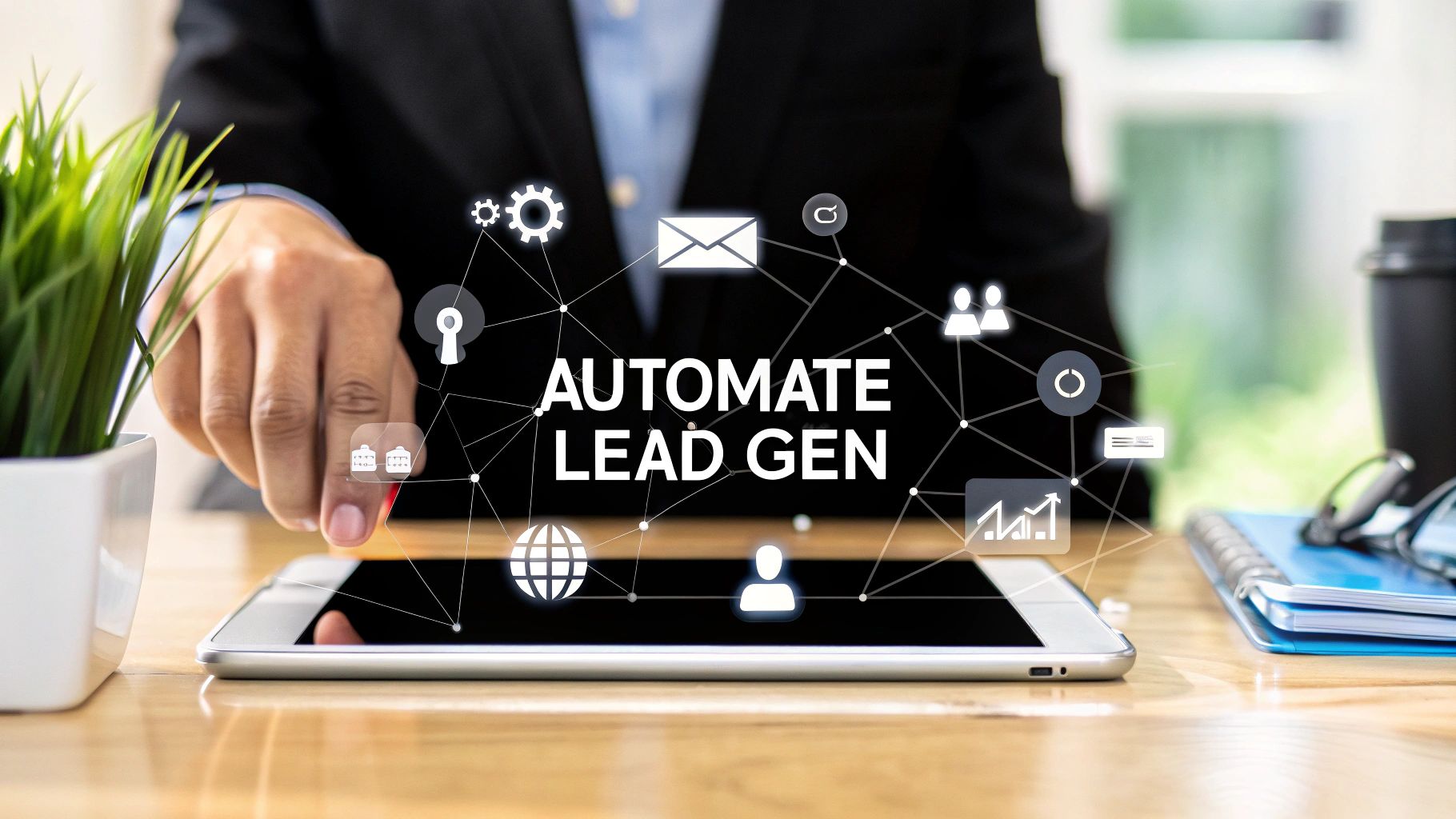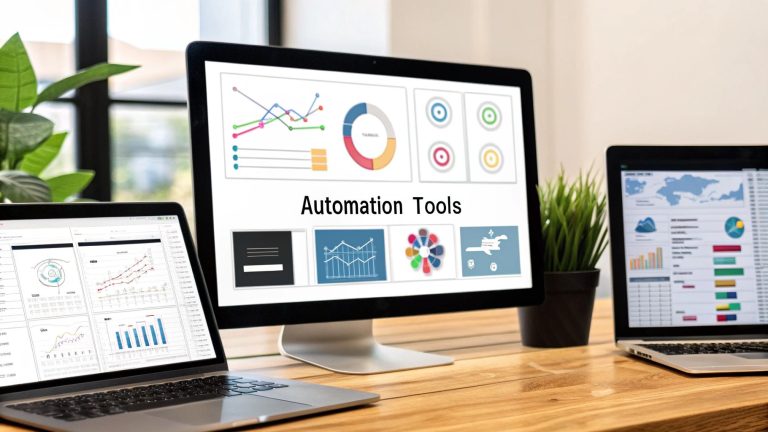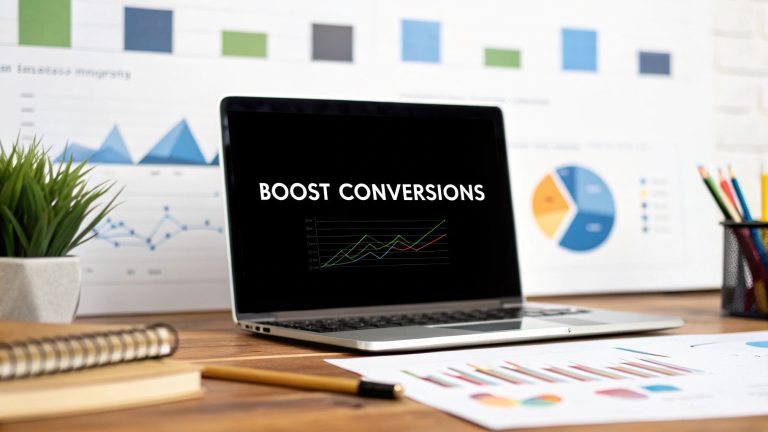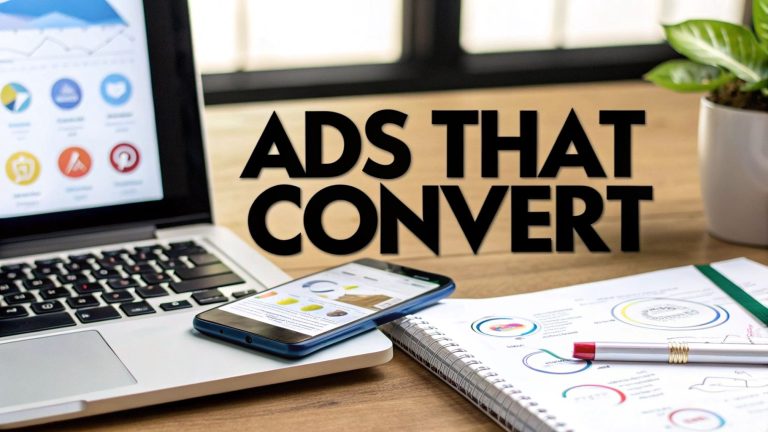How to Automate Lead Generation: Transform Your Sales Today
Understanding Why Smart Businesses Automate Lead Generation

The infographic above illustrates the difference between manual and automated lead generation. It focuses on three key performance indicators: leads generated per month, time spent per week, and conversion rate. The data clearly shows automated lead generation delivers superior results. Businesses using automation generate four times the leads, cut time spent by 80%, and more than double their conversion rate. This directly boosts revenue and frees up valuable resources.
This increased efficiency translates into a sustainable growth engine. Businesses can expand without a proportional increase in workload. Automating lead generation also optimizes resource allocation. Employees can concentrate on high-impact tasks, like nurturing qualified leads and closing deals, instead of repetitive manual tasks. You might be interested in: How to master marketing process optimization.
The Power of Consistency and Scalability
Automation brings consistency that's hard to achieve manually. Automated systems work 24/7, capturing and nurturing leads even when your team is off. A well-configured chatbot, for example, can answer questions, qualify leads, and schedule appointments at any time. This constant engagement keeps your sales pipeline full.
This constant activity makes scaling easier. As your business expands, lead generation efforts grow seamlessly without a huge increase in staff. This efficiency is vital for small and mid-sized businesses competing with larger companies. AI integration is a significant trend in lead generation automation. By 2025, 69% of high-performing sales teams are predicted to use AI to improve their work. Explore this topic further here.
Focusing on Quality Over Quantity
While automation generates a large volume of leads, the true benefit lies in the improved quality. Automated systems, such as LeadSavvy Pro, filter and segment leads based on your criteria. This ensures your sales team receives only the most qualified prospects. This targeted approach leads to more personalized communication and higher conversion rates.
Think of a fishing net that only catches the specific fish you want. That's what automated lead qualification does. By removing unqualified leads early, you save time and resources. Your team focuses on prospects with genuine buying potential. This precise targeting significantly improves return on investment.
To illustrate the differences between manual and automated lead generation, let's look at a comparison table:
The following table summarizes the key differences between traditional manual methods and automated approaches in terms of efficiency, cost, and results:
| Aspect | Manual Process | Automated Process | Impact |
|---|---|---|---|
| Lead Generation | Time-consuming research, outreach, and follow-up | Automated systems capture and nurture leads 24/7 | Increased lead volume and improved lead quality |
| Time Management | Significant time spent on repetitive tasks | Automated workflows free up time for strategic activities | Improved efficiency and productivity |
| Cost | High labor costs associated with manual efforts | Software and setup costs, often offset by increased efficiency | Reduced operational costs and improved ROI |
| Consistency | Difficult to maintain consistent outreach and follow-up | Automated systems ensure consistent engagement with leads | Improved lead nurturing and conversion rates |
| Scalability | Limited scalability due to manual resource constraints | Automated systems can easily scale to accommodate business growth | Enhanced growth potential |
| Personalization | Challenging to personalize communication at scale | Automated systems can segment leads and personalize messages | Improved engagement and conversion rates |
As the table highlights, automated lead generation offers substantial advantages over manual processes. From increased efficiency and scalability to improved lead quality and conversion rates, automation empowers businesses to achieve sustainable growth and maximize their ROI.
Choosing The Right Tools For Maximum Lead Generation Impact

Effective lead generation automation depends on selecting the right tools. It's not about having the most software. Instead, it's about strategically choosing platforms that integrate seamlessly to reach your specific goals. Think of it as building a high-performance race car. You need the perfect combination of engine, transmission, and tires working together to win.
Essential Tool Categories for Lead Generation Automation
Several key tool categories are essential for automating lead generation. These platforms form the foundation of any successful automated system:
-
CRM Systems (Customer Relationship Management): A CRM acts as your central hub, storing and organizing all your lead data. This allows for efficient tracking, segmentation, and personalized communication. It's the "brain" of your automation operation.
-
Email Marketing Platforms: These tools automate email sequences, nurture leads with targeted content, and track engagement. Email remains a powerful channel for converting leads into customers.
-
Social Media Automation Tools: Especially relevant for B2B businesses, these tools automate engagement on platforms like LinkedIn. They help you connect with decision-makers and nurture relationships. LinkedIn has become a major player. By 2028, it's projected to have over 942.84 million users. You can find more detailed statistics here: Lead Generation Statistics.
-
Landing Page Builders: These platforms allow you to create high-converting landing pages tailored to specific campaigns. Landing pages are crucial for capturing lead information and driving conversions.
-
Chatbots and Conversational Marketing Platforms: Chatbots engage website visitors in real-time, qualify leads, and offer instant support. They automate the initial stages of the sales process, capturing valuable information and nurturing early interest.
-
Lead Management Software: This type of software helps manage and nurture leads effectively, often integrating with other tools like CRM and email platforms. You can even find free options, as highlighted in this article: Lead Management Software Free.
Combining Tools for Maximum Impact
Top-performing companies often combine these tools strategically. For example, a lead captured through a Facebook ad can be automatically synced to a CRM using LeadSavvy Pro, which then triggers a personalized email sequence from your email marketing platform. This integrated approach creates a smooth and efficient lead generation machine.
Evaluating Features and Avoiding Pitfalls
Choosing the right tools also involves understanding which features truly matter. Don't get distracted by flashy features that don't contribute to your core objectives. Focus on essential functionalities:
-
Seamless Integrations: Your tools should communicate effectively with each other. Look for platforms that integrate with your existing systems.
-
Robust Reporting and Analytics: Data-driven decisions are key to optimization. Choose tools that provide comprehensive insights into your lead generation performance.
-
Scalability: As your business grows, your tools should scale with you. Select platforms that can handle increasing lead volumes and complexity.
-
Ease of Use: Intuitive interfaces and streamlined workflows are crucial for efficient automation. Avoid platforms with steep learning curves or complex setups. This is especially important for smaller businesses and teams with limited resources.
By carefully evaluating your needs and choosing the right tools, you can maximize the impact of your lead generation automation efforts and drive sustainable business growth. This strategic approach helps you build a lead generation engine that runs smoothly and efficiently, fueling your sales pipeline with qualified prospects. It's about creating a system that works for you, not the other way around.
Building Lead Scoring Systems That Actually Predict Sales
Not all leads are the same. Some are primed to purchase immediately, while others are just beginning their research. That's where lead scoring becomes essential. A well-constructed lead scoring system functions like a sieve, pinpointing the most promising prospects so your sales team can concentrate their efforts effectively. This prevents wasted time on leads unlikely to convert, ultimately increasing efficiency and revenue.
Understanding the Importance of Data-Driven Lead Scoring
Standard lead scoring models often fall short. They depend on general industry assumptions instead of the distinctive indicators within your specific market. Rather than making educated guesses, develop a scoring system grounded in actual conversion data. What behaviors and demographics truly predict buying intent for your company? This data-driven methodology is crucial for constructing a system that accurately reflects your sales pipeline. Companies are continually generating new leads, with an average of 1,877 leads per month. A substantial number, 81%, are already categorized as marketing-qualified leads (MQLs). You can find more in-depth statistics here: Lead Generation Statistics. This emphasizes the need for efficient scoring to effectively manage this volume.
Identifying Key Predictive Factors
Carefully examine your past conversions. What steps did your best customers take before making a purchase? Did they download specific resources, participate in webinars, or interact with particular pages on your website? These behavioral triggers are invaluable. For instance, if you discover that leads who download a specific case study convert at a higher rate, assign a significant score to that action.
Demographic factors, such as industry, company size, and job title, can also suggest a lead's potential value. However, exercise caution and don't rely on demographics exclusively. Combine them with behavioral triggers for a more comprehensive and precise score. Integrating a tool like LeadSavvy Pro can simplify the lead capture process from Facebook ad campaigns, automatically supplying this data to your scoring system.
Implementing and Refining Your Scoring System
Begin with a straightforward scoring model. Allocate points to essential actions and demographics based on their relationship to past conversions. Then, diligently track the outcomes. Are your highest-scoring leads converting as expected? If not, modify your criteria. Lead scoring is a continuous process. Ongoing refinement based on actual sales performance is vital for sustained success.
Common Lead Scoring Pitfalls to Avoid
-
Overcomplicating the System: Begin with a simple model and gradually increase complexity as needed. Too many factors can hinder management and interpretation.
-
Ignoring Sales Feedback: Your sales team possesses valuable insights. Regularly seek their input and incorporate it into your scoring criteria.
-
Setting and Forgetting: Consistently review and adapt your scoring system. Your market evolves, and your scoring system must keep pace.
By adhering to these principles, you can build a lead scoring system that effectively forecasts sales. This enables your team to concentrate on the most promising prospects and optimize their conversion efforts. This focused strategy cultivates a more effective sales process, enhances resource allocation, and ultimately propels revenue growth.
Crafting Email Sequences That Convert Without Feeling Robotic
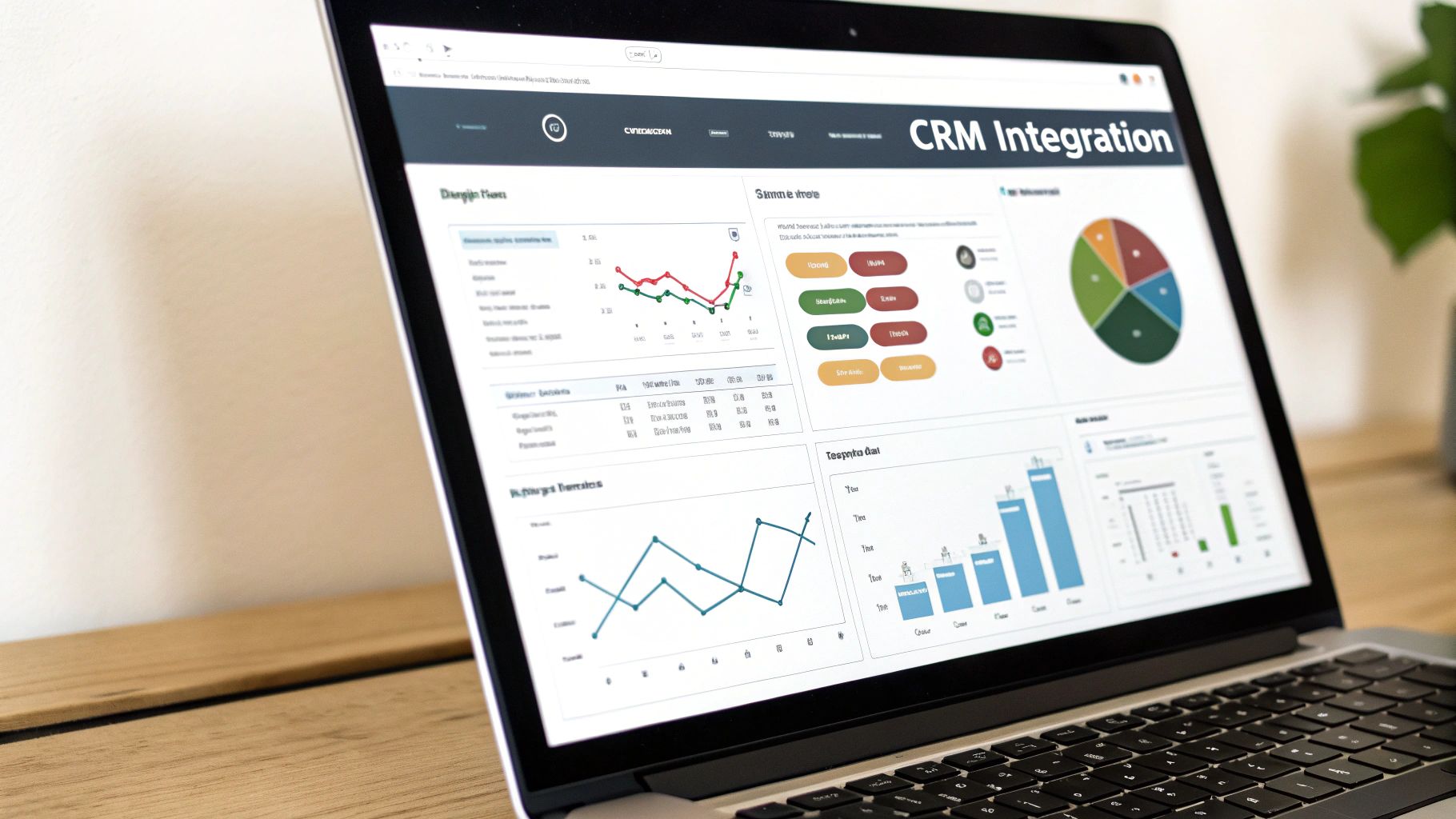
Email automation is a powerful tool for lead generation. However, many automated email sequences come across as impersonal and robotic, resulting in low engagement and even spam folder placements. This section explores how to create email sequences that convert while maintaining a genuine connection. This involves building trust with your audience and guiding them toward a purchasing decision.
The Psychology of Engaging Email Sequences
Effective email automation requires more than just scheduling messages. It necessitates understanding your prospects' psychology. What are their motivations and pain points? How can you provide value at every stage of their journey?
Think of your email sequence as a conversation, not a monologue. Each email should contribute to a broader narrative, building rapport and showcasing your expertise. This nuanced approach fosters trust and encourages recipients to interact with your content.
Just as researchers break down complex writing projects into smaller, manageable tasks to boost productivity and reduce anxiety, strategically structuring your email sequence can significantly improve your results. Learn more about research productivity here: Research Productivity Study.
Personalization Beyond the First Name
While using a prospect's first name is a positive step, genuine personalization goes much deeper. This involves segmenting your audience based on their behavior, interests, and demographics.
For example, if a lead downloads a particular resource, customize the subsequent emails to address the topics within that resource. This personalized touch demonstrates your understanding of their needs and increases the relevance of your message.
Consider also using dynamic content that adapts based on the recipient's profile or past interactions.
Timing and Frequency: Finding the Sweet Spot
The timing and frequency of your emails are crucial for effectiveness. Bombarding prospects with daily emails can be overwhelming and lead to unsubscribes.
Instead, strive for balance. Start with a welcome email immediately after a lead signs up. Then, strategically space out subsequent emails, giving prospects time to process the information and take action. Analyze your data to determine optimal send times and refine your schedule accordingly.
Crafting Compelling Subject Lines and Content
Your subject line is the first impression. It determines whether a prospect opens your email or deletes it. Create compelling subject lines that are concise, intriguing, and relevant to the email's content. Avoid generic phrases; instead, focus on offering value or addressing a specific pain point.
Within the email itself, deliver valuable content that educates, entertains, or solves a problem for your audience. Concentrate on building a relationship and establishing trust rather than aggressively pushing a sale.
Building Multiple Nurture Paths
Advanced email automation involves creating multiple nurture paths based on prospect behavior. For example, if a lead clicks a specific link in an email, trigger a different email sequence tailored to that interest.
This allows you to provide highly personalized content and guide leads down various paths based on their engagement. Tools like LeadSavvy Pro can simplify capturing leads from Facebook ad campaigns and integrating them into segmented email workflows, enhancing your automation strategy from the outset. This enables seamless integration and automated lead nurturing based on specific campaign interactions.
By combining powerful automation tools with a strategic email marketing approach, you can build an effective lead generation engine that converts prospects into loyal customers.
Implementing Chatbots That Generate Quality Leads
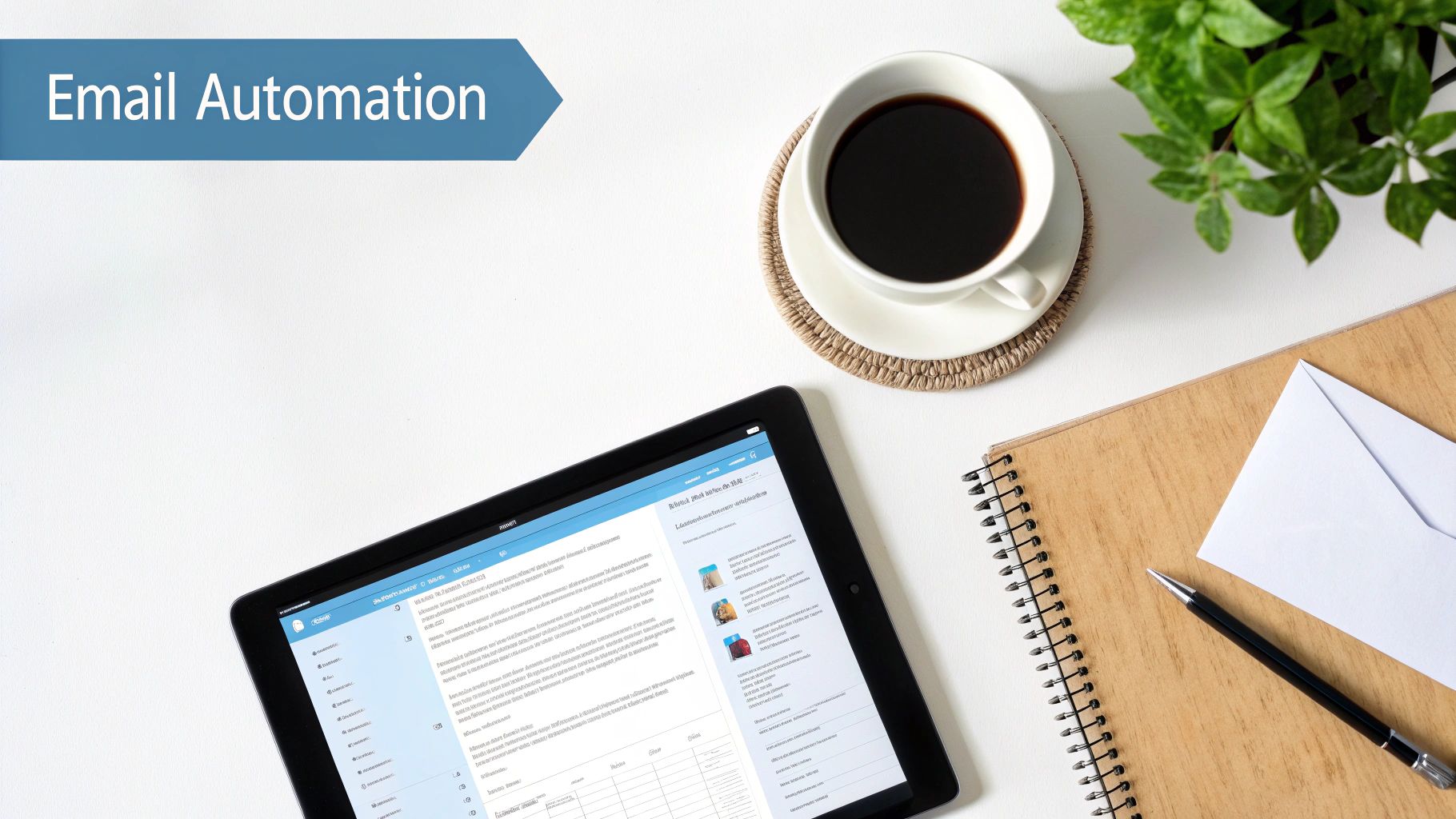
Today's customers want answers now. Chatbots, powered by conversational marketing automation, provide that instant connection. This section explores how businesses are using AI-powered chatbots as lead generation tools, going beyond simple customer service. These aren't just for answering FAQs; they're powerful engines for engaging prospects and gathering key information.
Designing Chatbot Conversations That Convert
Successfully using chatbots requires more than just adding one to your website. It's about designing conversations that turn visitors into qualified leads. This means understanding your audience, their needs, and how your product or service helps them. Just like a good sales pitch, your chatbot's conversation flow needs to be strategic and engaging, guiding the prospect smoothly through qualification.
This involves creating question flows that collect the right information without being pushy. For example, instead of immediately asking for a phone number, a chatbot could first offer valuable content related to the page the visitor is on. Once they show interest, the chatbot can then ask for contact information in exchange for the content. This "give first" approach feels more natural and less intrusive. Read also: How to automate your lead communication with LeadSavvy Pro's ClickSend SMS Integration.
Effective Qualification Techniques
A structured approach to chatbot conversations significantly improves lead qualification, similar to how academics benefit from organized note-taking for research. Research shows academics using systematic methods spend 40% less time on literature reviews and cite 35% more relevant sources. More detailed statistics can be found here: Literature Review Efficiency. Like good research, a structured chatbot conversation gathers better information. Here are some qualification techniques chatbots can use:
-
Asking qualifying questions: These questions help figure out the visitor's needs, budget, and who makes the decisions.
-
Offering multiple-choice options: This makes it easier for the visitor and allows for quick segmentation.
-
Using conditional logic: The chatbot can adjust the conversation and offer pertinent information based on the visitor's answers.
Seamless Handoff to Sales Teams
A key part of chatbot lead generation is the smooth transition from bot to human. Once a lead is qualified, the chatbot should seamlessly hand off the conversation to a sales representative. Here's how that might work:
-
Scheduling a call or demo: The chatbot can connect with your calendar to book appointments automatically.
-
Sending an email notification: The sales team gets real-time alerts about qualified leads, allowing for quick follow-up.
-
Providing a live chat option: For highly qualified leads, the chatbot can offer an immediate connection with a sales rep.
This handoff ensures warm leads get attention quickly, boosting conversion chances. Tools like LeadSavvy Pro can streamline this by automatically capturing leads from Facebook campaigns and sending them right to your CRM or email marketing platform.
Creating Engaging and Helpful Conversations
Chatbots shouldn’t feel like robots. They should offer a helpful and engaging experience. Here's how:
-
Using a conversational tone: Skip the formal language and give your chatbot some personality.
-
Providing quick and accurate answers: Visitors expect instant responses. Make sure your chatbot is quick and correct.
-
Offering valuable content: Share helpful resources like blog posts, case studies, or white papers to build trust and show expertise.
By focusing on these elements, you can create chatbot conversations that turn website visitors into qualified leads. This automated approach not only streamlines lead generation but also improves the overall customer experience, leading to better engagement and more sales.
Measuring and Optimizing Your Automated Lead Systems
Automation can transform lead generation from a tedious process into a powerful engine for growth. But simply setting up automated systems isn't enough. Without consistent measurement and optimization, automation can become a costly endeavor with minimal returns. This section focuses on the key metrics that drive revenue growth, moving beyond surface-level numbers to track the factors that truly matter.
Establishing a Robust Tracking System
Before optimizing, you need a solid tracking system. This means understanding not just the number of leads, but their origin, their interactions with your systems, and which ones convert into paying customers. Integrating your automation tools with analytics platforms is essential. Connecting your CRM, HubSpot, email marketing platform, Mailchimp, and chatbot software to a central dashboard, like those offered by Databox, gives you a holistic view of your lead generation performance. This comprehensive approach helps identify bottlenecks and areas for improvement across your entire lead generation funnel. Think of it like a car's diagnostic system – you need all the data points to pinpoint issues or enhance performance.
Key Metrics That Matter
While many metrics provide insights, some are more critical than others. Focus on these key performance indicators (KPIs):
-
Conversion Rate: This measures the percentage of leads who complete a desired action, such as filling out a form or making a purchase. Tracking conversion rates at each stage of your funnel pinpoints areas for improvement.
-
Cost Per Lead (CPL): This metric calculates the cost of acquiring each lead. Monitoring CPL helps you assess campaign efficiency and find ways to reduce costs.
-
Time to Conversion: This measures how long it takes a lead to convert. A shorter conversion time often indicates effective automation and efficient sales follow-up. Analyzing this metric helps optimize your lead nurturing process.
-
Customer Lifetime Value (CLTV): This metric measures the total revenue generated by a customer throughout their relationship with your business. Understanding CLTV allows you to prioritize high-value leads and tailor your automation strategies.
-
Return on Investment (ROI): The ultimate measure of success, ROI calculates the return generated for every dollar spent on lead generation automation. This metric demonstrates the overall effectiveness of your automated systems.
To help you visualize these key metrics, we've compiled the following table:
Key Lead Generation Automation Metrics
Essential KPIs to track for measuring the success of your automated lead generation efforts
| Metric | Description | Target Range | Optimization Tips |
|---|---|---|---|
| Conversion Rate | Percentage of leads completing a desired action | Varies by industry and campaign | Improve landing page copy, personalize emails, optimize chatbot conversations |
| Cost Per Lead (CPL) | Cost of acquiring each lead | As low as possible while maintaining quality | Refine targeting, optimize ad spend, explore cost-effective automation tools |
| Time to Conversion | Time taken for a lead to convert | As short as possible | Streamline lead nurturing, automate follow-up, personalize communication |
| Customer Lifetime Value (CLTV) | Total revenue generated by a customer | As high as possible | Improve customer retention, offer upsells and cross-sells, personalize the customer experience |
| Return on Investment (ROI) | Return generated for every dollar spent | Positive ROI | Optimize campaigns, reduce costs, improve conversion rates |
This table provides a framework for tracking and improving your automated lead generation efforts. By focusing on these key metrics, you can gain a clear understanding of what’s working and where you need to make adjustments.
Continuous Optimization and Scaling
Measuring your automated systems is an ongoing process. It requires regular monitoring, adjustments, and data-driven decisions to improve workflows. For example, if a landing page has a low conversion rate, A/B test different versions to see what resonates with your audience. If your CPL is too high, experiment with different targeting options or explore more cost-effective automation tools. LeadSavvy Pro offers a streamlined approach to Facebook lead capture, automatically syncing leads to your CRM or Google Sheet. This can significantly improve both conversion rate and CPL by ensuring prompt follow-up.
Once you have successful automated systems, it's time to scale. This might involve expanding automation to other areas of your business or adapting successful workflows to new campaigns. Scaling requires careful planning and execution. Don't simply replicate your systems. Adapt them to the specific needs of each new campaign or business area.
By diligently measuring and optimizing your automated lead systems, you can transform lead generation into a reliable source of high-quality prospects, fueling your sales pipeline and driving sustainable growth. This data-driven approach ensures your automation investments yield maximum returns and contribute to long-term success.

